Hong Kong was a city of contrasts on July 1. Just hours after the territory’s new chief executive, Leung Chun-ying (梁振英), was sworn into office amidst festivities of commemoration, a massive and orderly public demonstration clamored for Leung’s resignation, calling him a “wolf in sheep’s clothing” — representing the interests of the Chinese Communist Party, not those of the Hong Kong people.
Not surprisingly, the 15th anniversary of Hong Kong’s return to Chinese sovereignty, which coincided with the swearing in of Leung and his cabinet, brought the contrasts between media in China and Hong Kong into sharper focus as well.
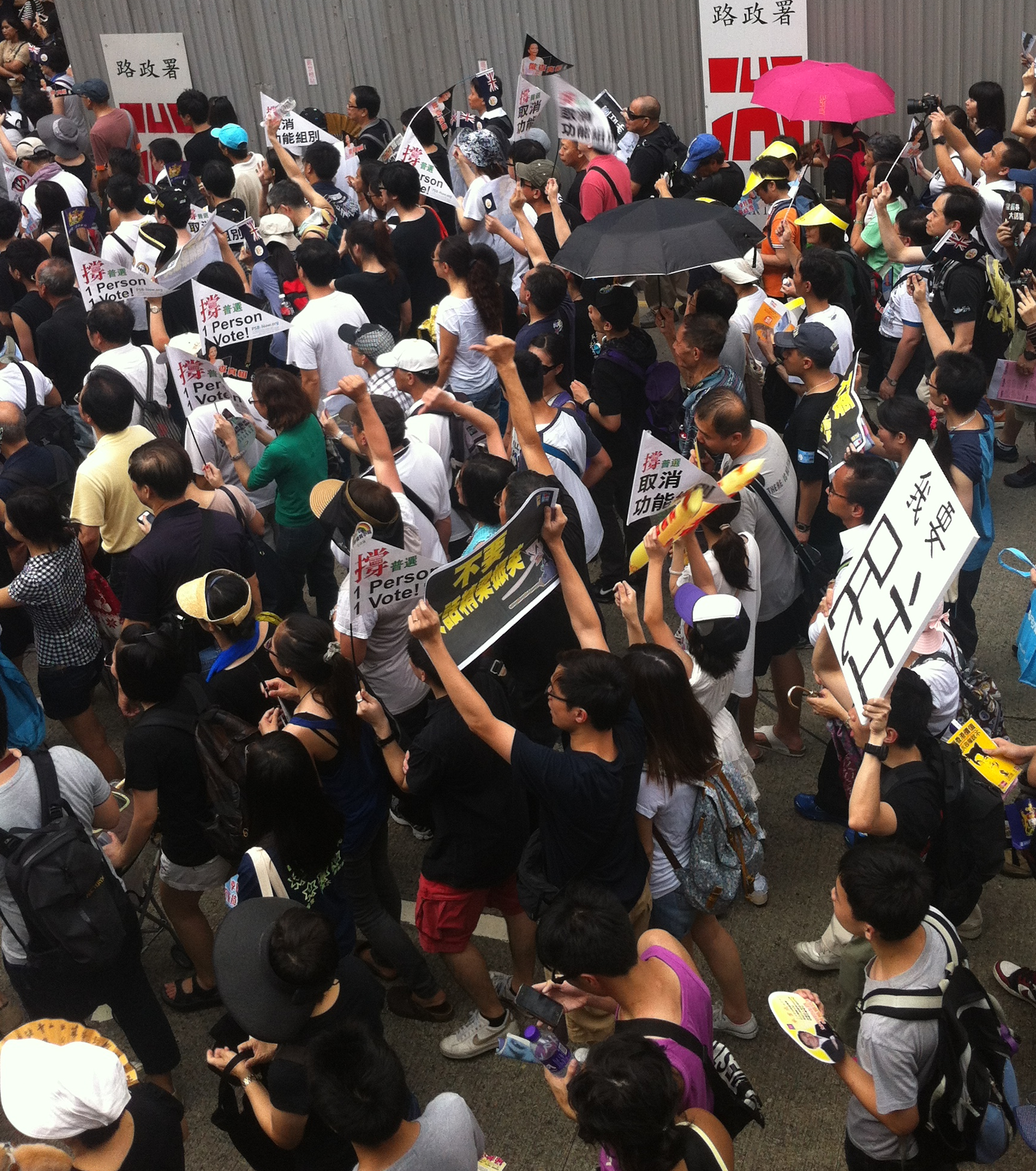
[ABOVE: Hong Kong residents turn out in the tens of thousands to call for greater democracy and the protection of civil rights, and to oppose the appointment of Leung Chun-ying as the territory’s next chief executive. Photo by Sara Yurich.]
Media in Hong Kong did report on the demonstrations, with coverage of the numbers topping the front pages at many papers. Like this report in Ming Pao Daily:
On the 15th anniversary of the handover, as a new government came to office, it was met with the third-largest demonstration in recent years, with demonstrators directing their criticism at newly-appointed chief executive Leung Chun-ying. The demonstrators did not stop, facing up against the hot sun and continuing up to the commencement of the fireworks display [to commemorate] the handover. The celebratory sound of fireworks presented a biting contrast to the masses [of protesters] clad in black and white. March organizers said that 400,000 took to the streets, while police said that at the height there were 63,000 people. Estimates from academics were 98,000-112,000, or 70,000-90,000 (see related reports).
A survey commissioned by this newspaper from the University of Hong Kong revealed that less than 40 percent of those surveyed believe Leung Chun-ying is suited to serve as chief executive, and 55 percent believe that he [Leung] “intentionally disguised” modifications to his property.(see page 4).
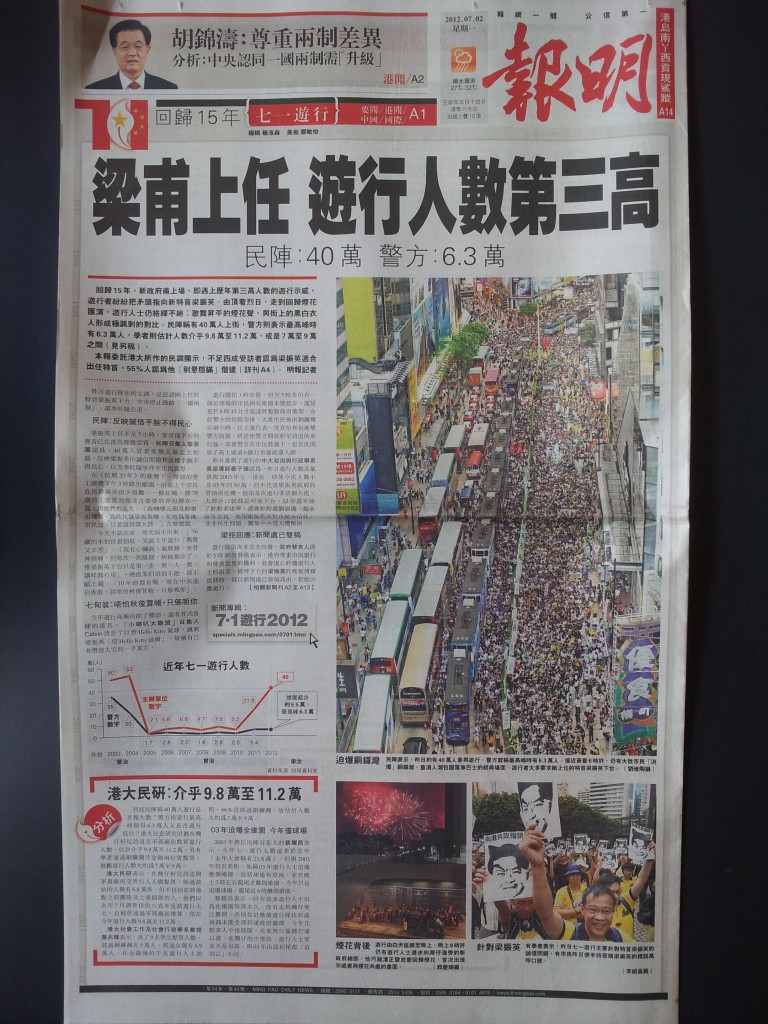
[ABOVE: The July 2 edition of Hong Kong’s Ming Pao Daily leads with demonstrations against the new chief executive, and competing estimates of the numbers.]
Here are a few other front pages from Hong Kong, all giving prominence to the June 1 demonstrations. Notably, the South China Morning Post makes the contrast explicit, running two images of equal size — one of the swearing in of the new chief executive (at left) and another of the demonstrations.
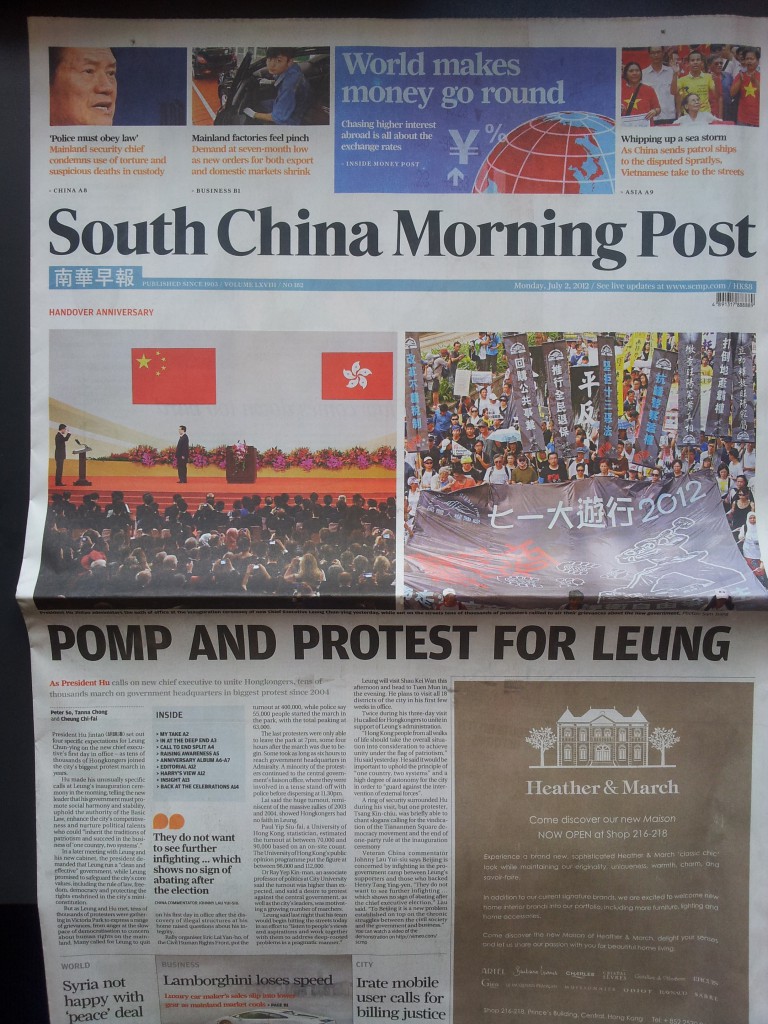
[ABOVE: Take your pick. The July 2 edition of Hong Kong’s South China Morning Post leads with demonstrations in the territory and the swearing in of its new chief executive.]
The Apple Daily, another of Hong Kong’s top newspapers, decides to use the estimate of demonstration participants given by the organizers — 400,000. There is no mention on the front page of competing estimates, as seen in Ming Pao Daily.
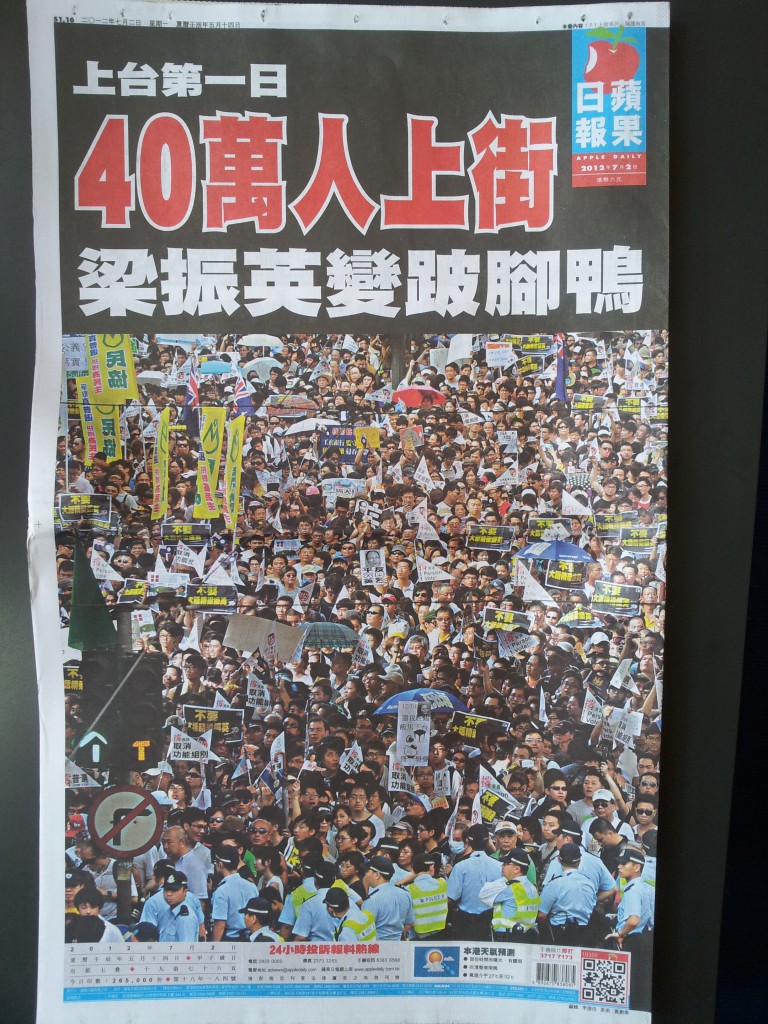
[ABOVE: The July 2 edition of Hong Kong’s Apple Daily leads with demonstrations.]
Not all Hong Kong papers led with coverage of the demonstrations, however. Ta Kung Pao and Wen Wei Po, both newspapers aligned with the government in China, led with the swearing in of Leung in the presence of Chinese President Hu Jintao, with large images of the ceremony set off by China’s national flag.
The papers put the primary focus on Hu Jintao’s speech, in which he outlined his “four hopes” for Hong Kong.
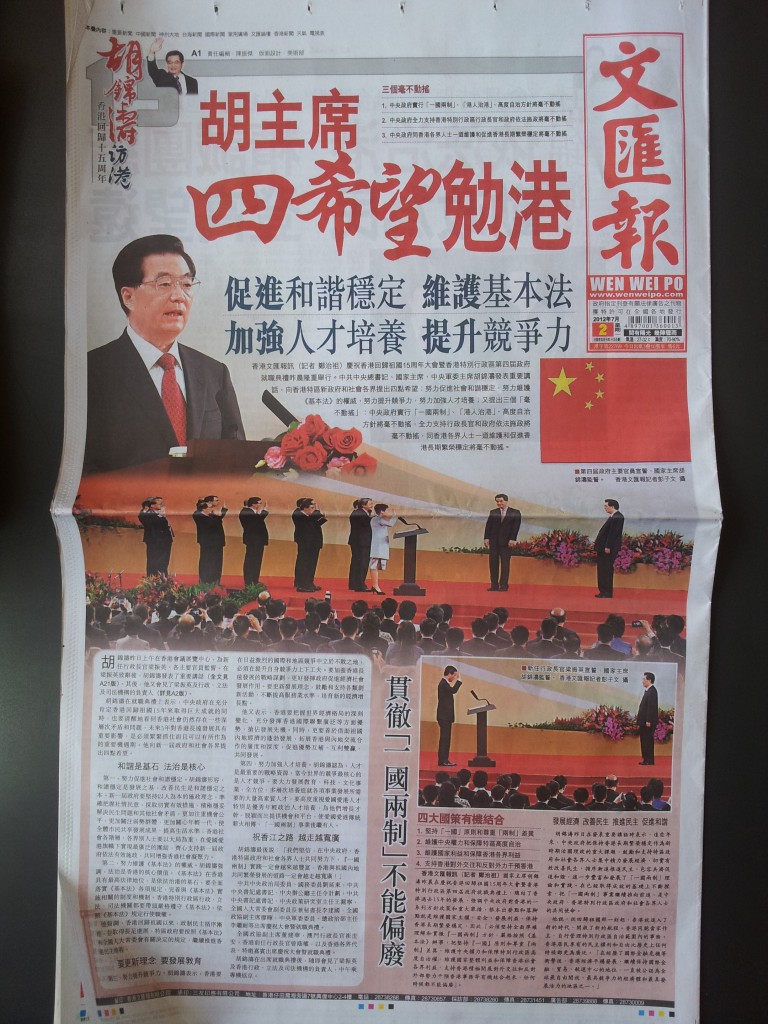
[ABOVE: The July 2 edition of Hong Kong’s Wen Wei Po leads with the swearing in of Hong Kong’s new chief executive.]
The Oriental Daily News also led with Chinese President Hu Jintao and the swearing in of Leung and his cabinet. Above the main headline, “Hu Jintao Lays Out Governance Direction for Hong Kong,” the paper also turned attention to President Hu’s warning about meddling by “external forces,” one of the more hardline notes in his official commemoration speech.
Hu said: “[We must] adhere to and implement a fully accurate ‘one country two systems’ policy, acting in strict accord with [Hong Kong’s] Basic Law, combining the priorities of upholding ‘one country’ while respecting differences in the ‘two systems,’ preserving the authority of the central Party and ensuring a high-level of autonomy in the Special Administrative Region, preserving overall national interests and ensuring various interests within Hong Kong society, supporting Hong Kong in actively developing international exchanges and opposing interference in Hong Kong affairs by outside forces . . .
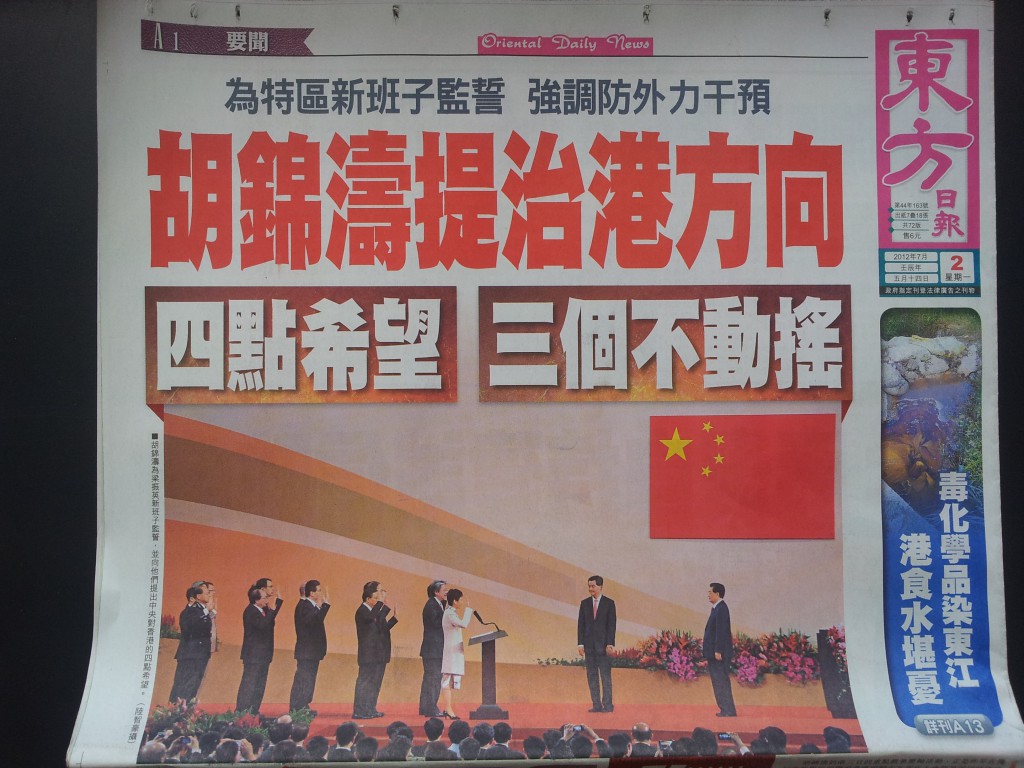
[ABOVE: The July 2 edition of Hong Kong’s Oriental Daily News leads with the swearing in of Hong Kong’s new chief executive.]
Media in mainland China leave us little to talk about. They were entirely dominated by official stories from Xinhua News Agency and China Central Television. They emphasized the formalities of the day, giving the most prominent coverage again to Hu Jintao’s speech, in which he voiced “four hopes” for Hong Kong and its people.
The following is a selected translation of Hu’s speech as posted to People’s Daily Online:
“Four Hopes for the New Hong Kong SAR Government and Various Walks of Society“
July 1, 2012
Compatriots, friends! As we fully affirm the massive achievements since Hong Kong returned to Chinese sovereignty 15 years ago, we also clearly see that Hong Kong society still has a number of deep-level tensions and problems. The next five years will have an important impact on the long-term development of Hong Kong. It is an important period of opportunity that must be fully grasped and during which differences can be made. Standing here, I express four hopes to the new government of the Hong Kong Special Administrative Region and to various walks of [Hong Kong] society.
First, [that Hong Kong] works hard to promote the stability and harmony of society. Harmony and stability are the foundation of development, and improving people’s lives is the basis of harmony and stability. The government of the Hong Kong SAR must abide by the vision of people-based governance, accurately grasping public opinion and the mood of society, adopting practical and effective measures to actively and reliably resolve the livelihood issues of the people and other social tensions, paying greater attention to social fairness, paying greater attention to the weaker segments of society, giving greater care to the younger generation, so that all citizens can share in the fruits of development and raise their living standards.
All segments of Hong Kong society must set store by general interests, achieving the broadest sense of unity under the banner of love of country and love of Hong Kong, supporting with one heart the new government as it governs effectively by rule of law, working in common to raise the cohesiveness of Hong Kong society.
Second, [that Hong Kong] works hard to preserve the authority of the Basic Law. Rule of law is a core value of Hong Kong. The Basic Law is the highest law in the Hong Kong SAR, and the cornerstone of governance of Hong Kong by rule of law. . .
Third, [that Hong Kong] works hard to raise its competitiveness. If Hong Kong is to secure an unassailable position in the midst of increasingly fierce international and regional competition, it must makes strides in raising its own competitiveness. [We must] strengthen strategic plans for Hong Kong’s long-term development, better utilizing the role of the government in promoting economic and social development. . . At the same time, there must be better mutual cooperation with the mainland of the mother country (祖国内地) to promote sound development, deepening and expanding dialogue and cooperation between Hong Kong and the mainland of the mother country, promoting mutual advantage, mutual gain and common development.
Fourth, [that Hong Kong] works hard to strengthen the training of talent . . .
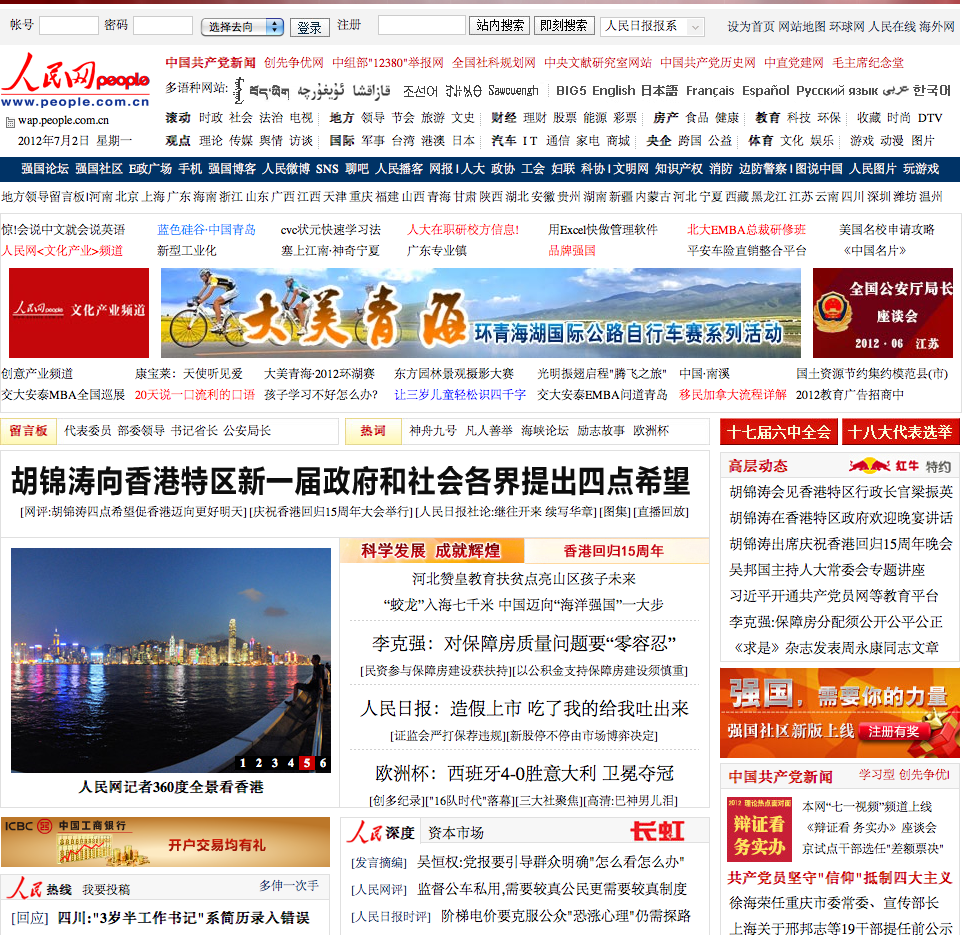
[ABOVE: On July 2, 2012, the homepage of People’s Daily Online is dominated by a headline about Hu Jintao’s “four hopes” for Hong Kong, which leads to a whole page of official coverage, with no mention at all of demonstrations.]
But according to another story in the July 2 edition of Hong Kong’s Ming Pao Daily, the 15th anniversary of the handover presented a contrast not just of media coverage, but also of media cultures.
As the flag-raising ceremony was held in Wan Chai’s Golden Bauhinia Square on the morning of July 1, the scene was (as could be expected) filled with local Hong Kong media clamoring to cover the story. Official Chinese state media were also there, including the state-run China Central Television.
About 10 minutes before the flag-raising ceremony was set to begin, the new chief executive arrived with his wife. The pair made the rounds, shaking hands and chatting with onlookers. Local news photographers and television reporters rushed around them.
As one photographer pressed through to get a shot, they were blocked by a reporter from China Central Television. CCTV was doing a live broadcast, the reporter explained, and everyone else needed to stay out of the shot.
The Hong Kong reporter fired back, in affirmation of his own rights and in flat denial of CCTV’s special privileges: “This is Hong Kong!”




















